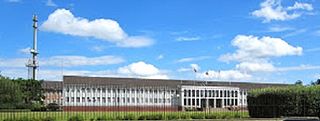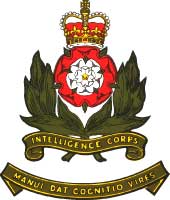
The Battle of Mount Harriet was an engagement of the Falklands War, which took place on the night of 11/12 June 1982 between British and Argentine forces. It was one of three battles in a Brigade-size operation all on the same night, the other two being the Battle of Mount Longdon and the Battle of Two Sisters.

The 3rd Division, also known as The Iron Division, is a regular army division of the British Army. It was created in 1809 by Arthur Wellesley, 1st Duke of Wellington, as part of the Anglo-Portuguese Army, for service in the Peninsular War, and was known as the Fighting 3rd under Sir Thomas Picton during the Napoleonic Wars. The division fought at the Battle of Waterloo, as well as during the Crimean War and the Second Boer War. As a result of bitter fighting in 1916, during the First World War, the division became referred to as the 3rd (Iron) Division, or the Iron Division or Ironsides. During the Second World War, the division fought in the Battle of France including a rearguard action during the Dunkirk Evacuation, and played a prominent role in the D-Day landings of 6 June 1944. The division was to have been part of a proposed Commonwealth Corps, formed for a planned invasion of Japan in 1945–46, and later served in the British Mandate of Palestine. During the Second World War, the insignia became the "pattern of three" — a black triangle trisected by an inverted red triangle.

The 1st Division is an active division of the British Army that has been formed and disestablished numerous times between 1809 and the present. In its original incarnation as the 1st Division, it took part in the Peninsular War—part of the Coalition Wars of the Napoleonic Wars—and was disbanded in 1814 but was re-formed the following year for service in the War of the Seventh Coalition and fought at the Battle of Waterloo. It remained active as part of the British occupation of France until it was disbanded in 1818, when the British military withdrew. The division was then raised as needed; it served in the Crimean War, the Anglo-Zulu War, and the Second Boer War. In 1902, the British Army formed several permanent divisions, which included the 1st Division, which fought in the First World War, made various deployments during the interwar period, and took part in the Second World War when it known as the 1st Infantry Division.

Royal Air Force Chicksands or more simply RAF Chicksands, was a Royal Air Force station located 7.7 miles south east of Bedford, Bedfordshire and 11.6 miles north east of Luton, Bedfordshire. It closed in 1997 when responsibility for the camp was taken over by the British Army Intelligence Corps. Near the town of Shefford it is named after Chicksands Priory, a 12th-century Gilbertine monastery located within the perimeter of the camp.
The 1st Green Jackets was an infantry regiment of the British Army that existed from 1958 to 1966. The regiment served in the Cyprus Emergency, Brunei Revolt, Indonesia-Malaysia confrontation and West Berlin. The regiment formed part of the Green Jackets Brigade and in 1963 was redesignated as a rifle regiment.

A brigade major was the chief of staff of a brigade in the British Army. They most commonly held the rank of major, although the appointment was also held by captains, and was head of the brigade's "G - Operations and Intelligence" section directly, and oversaw the two other branches, "A – Administration" and "Q – Quartermaster". Intentionally ranked lower than the lieutenant colonels commanding the brigade's combat battalions, his role was to expand on, detail and execute the intentions of the commanding brigadier.

The former Royal Air Force Rheindahlen, more commonly known as RAF Rheindahlen, was a non-flying Royal Air Force (RAF) military administrative base, becoming part of the Rheindahlen Military Complex in North Rhine-Westphalia, Germany; collectively a part of British Forces Germany (BFG). The Royal Air Force station was named after the nearby town and railway station of Rheindahlen. In the 1950s and 1960s, it was more commonly referred to as RAF Mönchengladbach; due to Rheindahlen being the Army's name for the same JHQ. It was unusual in that the RAF station land was publicly accessible, with public transport routes, and even German civilian mail service.

JHQRheindahlen was a military base in Mönchengladbach, North Rhine-Westphalia, Germany active from 1954 to 2013. It functioned as the main headquarters for British forces in Germany and for the NATO Northern Army Group. Latterly it was also known as the Rheindahlen Military Complex, part of Rheindahlen Garrison. It was named after the local village of Rheindahlen, part of the city borough of Mönchengladbach.
The 602 Commando Company is a special operations unit of the Argentine Army.

The 5th Infantry Brigade was a regular infantry brigade of the British Army that was in existence since before the First World War, except for a short break in the late 1970s. It was an Airborne Brigade from the early 1980s until amalgamating with 24th Airmobile Brigade, in 1999, to form 16 Air Assault Brigade.

Operation Banner was the operational name for the British Armed Forces' operation in Northern Ireland from 1969 to 2007, as part of the Troubles. It was the longest continuous deployment in British military history. The British Army was initially deployed, at the request of the unionist government of Northern Ireland, in response to the August 1969 riots. Its role was to support the Royal Ulster Constabulary (RUC) and to assert the authority of the British government in Northern Ireland. This involved counter-insurgency and supporting the police in carrying out internal security duties such as guarding key points, mounting checkpoints and patrols, carrying out raids and searches, riot control and bomb disposal. More than 300,000 soldiers served in Operation Banner. At the peak of the operation in the 1970s, about 21,000 British troops were deployed, most of them from Great Britain. As part of the operation, a new locally-recruited regiment was also formed: the Ulster Defence Regiment (UDR).
The Battle of Babang was the fourth and last in a series of successful ambushes conducted between in May and July 1965 by Australian troops from 3rd Battalion, Royal Australian Regiment, this time at Babang in Kalimantan, during the Indonesia-Malaysia Confrontation. The ambushes were conducted under the wider British-Commonwealth Operation Claret, being cross-border operations mounted from bases in Sarawak up to 10,000 yards (9,100 m) into Indonesian territory with aim of disrupting the movement and resupply of Indonesian forces and to keep them off balance.

The Northern Army Group (NORTHAG) was a NATO military formation comprising four Western European Army Corps, during the Cold War as part of NATO's forward defence in the Federal Republic of Germany.

No. 10 (Inter-Allied) Commando was a commando unit of the British Army during the Second World War, recruited largely from non-British personnel from German-occupied Europe. This unit was used to help co-ordinate attacks with other allied forces.
The Northern Army Group (NORTHAG) was a NATO military formation comprising five Army Corps from five NATO member nations. During the Cold War NORTHAG was NATO's forward defence in the Northern half of the Federal Republic of Germany (FRG). The Southern half of the Federal Republic of Germany was to be defended by the four Army Corps of NATO's Central Army Group (CENTAG). During wartime NORTHAG would command four frontline corps and one reserve corps. Air support was provided by Second Allied Tactical Air Force.

The Battle of Newry Road was a running gun battle between British Army helicopters and Provisional Irish Republican Army (IRA) armed trucks, fought along the lanes east of Crossmaglen, County Armagh, on 23 September 1993. The engagement began when an IRA motorized team from the South Armagh Brigade attempted to ambush three helicopters lifting off from the British Army base at Crossmaglen, one of them carrying the 3rd Infantry Brigade Commander.
The Provisional IRA (IRA) planted a bomb underneath a minibus at an army recruiting centre in Wembley, northwest London on 16 May 1990, killing a soldier and injuring four others. The dead victim was the van's driver, 34-year-old Sergeant Charles Chapman from the Queen's Regiment, a father of two. The injured included his colleague, who got shrapnel wounds to his legs and right shoulder, and a burned face. The bomb was believed to have been 2 lb (910 g) of Semtex and shattered nearby windows when it exploded around 5:15 pm. The van was an unmarked white Leyland Sherpa parked in an alleyway behind the office, which was checked by the two soldiers beforehand but the bomb was cleverly hidden, and detonated as Chapman turned on the ignition. The bomb could have caused more casualties had it exploded later when the van entered the busy street.
The following is a hierarchical outline for the structure of the British Army in 1989. The most authoritative source for this type of information available is Ministry of Defence, Master Order of Battle, and United Kingdom Land Forces, HQ UKLF, UKLF ORBAT Review Action Plan, HQ UKLF, 1990.
The 4th Signal Group was a group sized unit of the Royal Corps of Signals within the British Army that supported the British Army of the Rhine. The group's main job was to supervise all of the static communications used by the British Forces in Germany. It supported the British Army of the Rhine and 2nd Allied Tactical Air Force for just under 30 years.

5 Military Intelligence Battalion is an Intelligence Corps Army Reserve unit in the British Army. It is based in Scotland, with sub-units in Edinburgh, Gateshead and Leeds and detachments in Glasgow and Chesterfield. It is partnered with 1 Military Intelligence Battalion, a Regular Army unit based in Catterick Garrison, North Yorkshire.













